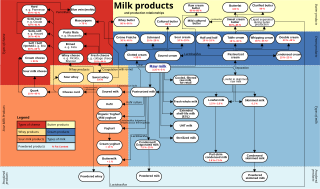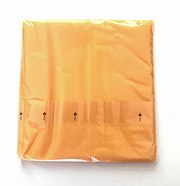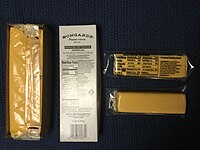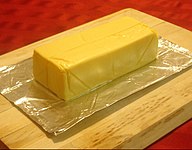
Dairy products or milk products, also known as lacticinia, are food products made from milk. The most common dairy animals are cow, water buffalo, nanny goat, and ewe. Dairy products include common grocery store food around the world such as yogurt, cheese, milk and butter. A facility that produces dairy products is a dairy. Dairy products are consumed worldwide to varying degrees. Some people avoid some or all dairy products because of lactose intolerance, veganism, or other health reasons or beliefs.

Milk is a white liquid food produced by the mammary glands of mammals and the caecilian Siphonops annulatus. It is the primary source of nutrition for young mammals before they are able to digest solid food. Immune factors and immune-modulating components in milk contribute to milk immunity. Early-lactation milk, which is called colostrum, contains antibodies that strengthen the immune system and thus reduce the risk of many diseases. Milk contains many nutrients, including protein and lactose.

Pizza cheese encompasses several varieties and types of cheeses and dairy products that are designed and manufactured for use specifically on pizza. These include processed and modified cheese, such as mozzarella-like processed cheeses and mozzarella variants. The term can also refer to any type of cheese suitable for use on pizza. The most popular cheeses used in the preparation of pizza are mozzarella, provolone, cheddar and Parmesan. Emmental, pecorino romano and ricotta are often used as toppings, and processed pizza cheeses manufactured specifically for pizza are mass-produced. Some mass-produced pizza cheeses are frozen after manufacturing and shipped frozen.

Casein is a family of related phosphoproteins that are commonly found in mammalian milk, comprising about 80% of the proteins in cow's milk and between 20% and 60% of the proteins in human milk. Sheep and cow milk have a higher casein content than other types of milk with human milk having a particularly low casein content.

Buttermilk is a fermented dairy drink. Traditionally, it was the liquid left behind after churning butter out of cultured cream. As most modern butter in western countries is not made with cultured cream but uncultured sweet cream, most modern buttermilk in western countries is cultured separately. It is common in warm climates where unrefrigerated milk sours quickly.

KD in Canada, Kraft Mac & Cheese in the United States, Australia and New Zealand, Mac and Cheese in the United Kingdom and internationally, is a nonperishable, packaged macaroni and cheese product. It is made by Kraft Foods Group and traditionally cardboard-boxed with dried macaroni pasta and a packet of processed cheese powder. It was introduced under the Kraft Dinner name simultaneously in both Canada and the U.S. in 1937. The brand is particularly popular with Canadians, who consume 55% more boxes per capita than Americans.

Cheez Whiz is a brand of processed cheese sauce or spread produced by Kraft Foods. It was developed by a team led by food scientist Edwin Traisman (1915–2007). It was first sold in 1952, and with some changes in formulation continues to be in production today.

Trisodium citrate has the chemical formula of Na3C6H5O7. It is sometimes referred to simply as "sodium citrate", though sodium citrate can refer to any of the three sodium salts of citric acid. It possesses a saline, mildly tart flavor, and is a mild alkali.

Kraft Singles is a brand of processed cheese product manufactured and sold by Kraft Heinz. Introduced in 1950, the individually wrapped "slices" are not really slices off a block, but formed separately in manufacturing.

Velveeta is a brand name for a processed cheese similar to American cheese. It was invented in 1918 by Emil Frey (1867-1951) of the Monroe Cheese Company in Monroe, New York. In 1923, The Velveeta Cheese Company was incorporated as a separate company. In 1925, it advertised two varieties, Swiss and American. The firm was purchased by Kraft Foods Inc. in 1927.

American cheese is a type of processed cheese made from cheddar, Colby, or similar cheeses, in conjunction with sodium citrate, which permits the cheese to be pasteurized without its components separating. It is mild with a creamy and salty flavor, has a medium-firm consistency, and has a low melting point. It is typically yellow or white in color; yellow American cheese is seasoned and colored with annatto.

Calcium caseinate is one of several milk proteins derived from casein in skim and 1% milk. Calcium caseinate has a papery, sweet and overall bland flavor, and is primarily used in meal preparation and fat breakdown. Caseinates are produced by adding an alkali to another derivative of casein, acid casein. The type of caseinate is determined by the cation added alongside the acid casein. Other cations used to form caseinates besides calcium include ammonium, potassium, and sodium.

Easy Cheese is the trademark for a processed cheese spread product distributed by Mondelēz International. It is also commonly referred to by generic terms such as "spray cheese", "squirt cheese" or "cheese in a can". Easy Cheese is packaged in a metal can filled with air covered with a plastic cap that reveals a straight, flexible nozzle where the cheese is extruded.

Government cheese is processed cheese provided to welfare beneficiaries, Food Stamp recipients, and the elderly receiving Social Security in the United States, as well as to food banks and churches. This processed cheese was used in military kitchens during World War II and has been used in schools since the 1950s.

Pasta filata is a technique in the manufacture of a family of Italian cheeses also known in English as stretched-curd, pulled-curd, and plastic-curd cheeses. Stretched curd cheeses manufactured using the pasta filata technique undergo a plasticising and kneading treatment of the fresh curd in hot water, which gives the cheese its fibrous structure.

Cheese analogues are products used as culinary replacements for cheese. They are usually products made by blending other fats or proteins and used in convenience foods. The category includes vegan cheeses as well as some dairy-containing products that do not qualify as traditional cheeses, such as processed cheese. These foods may be intended as replacements for cheese, as with vegan products, or as alternatives, as in the case of products used for salad bars and pizza-making, that may have other properties such as lower cholesterol content or different melting points that make them attractive to businesses.

Granular cheese, also known as stirred curd cheese and hard cheese, is a type of cheese produced by repeatedly stirring and draining a mixture of curd and whey. It can refer to a wide variety of cheeses, including the grana cheeses such as Parmigiano-Reggiano (pictured) and various others.
Milk protein concentrate (MPC) is any type of concentrated milk product that contains 40–90% milk protein. The United States officially defines MPC as "any complete milk protein concentrate that is 40 percent or more protein by weight." In addition to ultrafiltered milk products, the MPC classification includes concentrates made through other processes, such as blending nonfat dry milk with highly concentrated proteins, such as casein.

Vegan cheese is a category of non-dairy, plant-based cheese analogues. Vegan cheeses range from soft fresh cheeses to aged and cultured hard grateable cheeses like plant-based Parmesan. The defining characteristic of vegan cheese is the exclusion of all animal products.

Sour cream is a dairy product obtained by fermenting regular cream with certain kinds of lactic acid bacteria. The bacterial culture, which is introduced either deliberately or naturally, sours and thickens the cream. Its name comes from the production of lactic acid by bacterial fermentation, which is called souring. Crème fraîche is one type of sour cream with a high fat content and less sour taste.




























